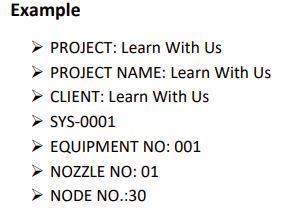🌟 What is Nozzle Qualification in NozzlePro?
Nozzle Qualification is basically checking if a nozzle on a pressure vessel or equipment is strong enough to handle the forces and moments coming from the connected piping system.
When piping is connected to a nozzle, it applies loads like pulling, pushing, bending, and twisting. We need to make sure that these loads won’t damage the nozzle or vessel, and that the stress is within the safe limits as per codes like ASME Sec VIII, Div 1/2 or WRC 107/297.
📌 Why do we do Nozzle Qualification?
- To check if the nozzle is safe when piping loads act on it.
- To make sure that stresses at the nozzle-shell junction are acceptable.
- To verify that the design meets code requirements, and there’s no risk of failure.
- To document compliance for clients and authorities.
✅ Key Points:
- Uses corroded thickness for checking — because that's the worst-case scenario.
- Considers actual loads from piping (forces, moments).
- Provides a pass/fail result, showing if the nozzle is safe or not.
🌟 What is Nozzle Flexibility in NozzlePro?
Nozzle Flexibility is about figuring out how much the nozzle will move or rotate when loads are applied — kind of like checking how "stiff" or "flexible" the nozzle is.
In piping stress analysis, we need to know if a nozzle will "give" a little under load, or if it's very stiff — because this affects the whole piping system's behavior.
📌 Why do we calculate Nozzle Flexibilities?
- To input realistic stiffness/flexibility values into pipe stress analysis software like CAESAR II, AutoPIPE, etc.
- To avoid overestimating loads on the nozzle — because if the nozzle is flexible, it can reduce the loads transmitted to the vessel.
- To help ensure the equipment and piping system work safely together.
✅ Key Points:
- Uses un-corroded (nominal) thickness — because we are checking elastic behavior, not code limits.
- Helps in accurate load distribution between pipe and vessel.
- Important for critical equipment nozzles connected to large or high-temperature piping.
⚙️ Simple Difference Between Both:
💡 Simple way to remember:
- Nozzle Qualification = "Can the nozzle handle the load without damage?" ✅❌
- Nozzle Flexibility = "How much will the nozzle bend or move when loaded?" ↔️🔁
✅ Steps for Nozzle Qualification / Nozzle Flexibilities in NozzlePro
Filename Convention:
- Nozzle Qualification filename: NozzlePro_Equipment Name_Nozzle name_Node number
- Nozzle Flexibilities filename: NozzleFlexibilities_Equipment Name_Nozzle name_Node number
- -Wall thickness = corroded thickness (Nozzle Qualification)
- -Wall thickness = non-corroded thickness (Nozzle Flexibilities)
- -For elliptical head, if nominal and minimum thickness is given, consider minimum thickness for calculation.
- -Optional parameters not to be entered unless the nozzle is offset.
Input Parameters for Shell:
Based on the nozzle profile: select nozzle / attachment type.
Input Parameters for Nozzle:
- -Wall thickness = corroded thickness (Nozzle Qualification)
- -Wall thickness = non-corroded thickness (Nozzle Flexibilities)
- -Nozzle length shall include flange length.
- -Units – English.

- Loads to be applied at Nozzle-Shell junction.
- -Weight loads: consider max. loads out of operating and design sustained loads.
- -Operating loads: consider max. loads out of operating and design operating loads.
- -Occasional loads: consider max. loads out of pure occasional loads like wind, seismic, reaction force, snow, etc. (Nozzle Qualification).
- Nozzle Flexibilities:
- -All loads should be 0.
- -Nozzle inside/outside temperature and Shell inside/outside temperature shall be design temperature of equipment.
- -Design pressure as per equipment; Operating pressure as per line.
















